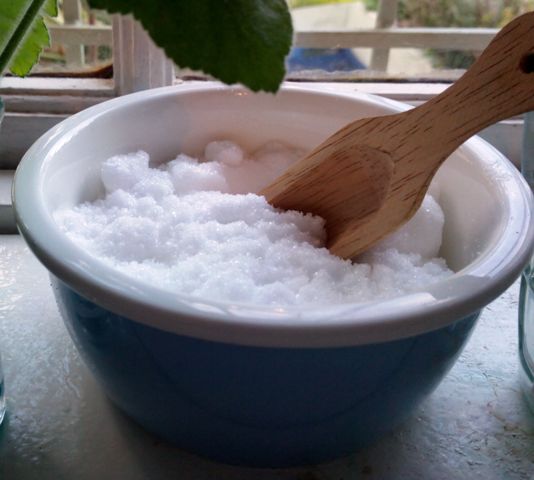
Versatile, naturally occurring, inexpensive and beneficial – Epsom salts have been used in homes and gardens for generations and certainly deserve a place here at Spotless.

Epsom salts
Epsom salts have plenty of uses in the home (more on that another day), but with Spring in full swing I’ve been particularly enjoying their many benefits in the garden. Apart from strengthening plants generally, Epsom salts is renowned among gardeners for producing greener, lusher foliage; brighter and more numerous flowers; and tastier, sweeter and more abundant fruits and vegetables. Tell-tale signs that your plants may be craving a drink of Epsom salts include yellowing of the leaves, especially between the leaf veins, leaf curling, stunted growth, and fruits lacking in sweetness.
Why Epsom salts helps plants
Epsom salts are composed of magnesium and sulphur, combined with oxygen and water molecules. Magnesium in particular is vital for life. Magnesium forms the central atom of a chlorophyll molecule and is what enables plants to convert sunlight into food. All green plants are dependent on chlorophyll for photosynthesis, and magnesium is necessary for plants to produce chlorophyll. It is an essential mineral for plant growth, seed germination, and the production of fruit and nuts. Magnesium also strengthens the cell walls of plants, making them generally stronger, and improves their uptake of the other essential nutrients: nitrogen, phosphorous, and sulphur. Sulphur, the other mineral in Espom salts, is also involved in chlorophyll production and plants need it to form proteins and oils and to develop and activate vitamins and enzymes. It also gives many vegetables their distinctive flavours.
Epsom salts are a hydrated form of magnesium sulphate that are very water soluble. This means you can mix the salts with water and they will sink easily into the soil and be easily taken up by plants through the roots. Possibly even more effective is to spray a solution of Epsom salts and water directly onto plants’ foliage. Epsom salts are useful to plants at all stages of life, from seed germination onward.
How to feed your garden Epsom salts
-
- Sprinkle a little Epsom salts into your soil before planting seedlings or seeds and work it into the soil (about a cup per 100 square feet)
- Soak root balls in a solution of Epsom salts (about one tablespoon per litre of water) prior to planting out.
- Revitalise your lawn by watering it with a weak solution of Epsom salts (about one tablespoon per four litres of water) once a month, especially in the Spring.
- Dissolve one to two tablespoons of Epsom salts per four litres of water. Use this solution to water pot plants, fruit trees and rose bushes, as well as any plant needing a boost, drenching the plant at its base.
- Regularly water vegetables, especially tomatoes and peppers which use up a lot of magnesium, with the same solution as above.
- Roses love Epsom salts. Sprinkle one tablespoon per foot of the plant’s height around the base of the plant and water it in, once a month during the growing season.
As if all this weren’t enough, Epsom salts can help you in the garden in another way – they make an excellent non-toxic deterrent to snails and slugs. Just sprinkle the salts wherever the creatures glide and they’ll steer clear.
Should you get a splinter during all this work in the garden, you can use Epsom salts to draw it out. Either soak your finger in a solution of one teaspoon Epsom salts in a cup of warm water, or put a pinch on the dressing patch of a plaster (band-aid) and apply it over the splinter. Remove and reapply twice a day until the splinter has worked its way out enough to be removed.
Interested in Advertising with Us?
Promote your brand and reach an engaged audience who values quality, sustainability, and healthy living.
Contact us to learn about our advertising opportunities.
CONTACT US